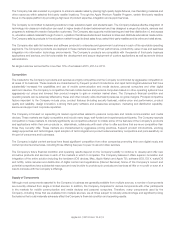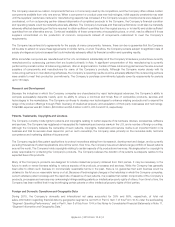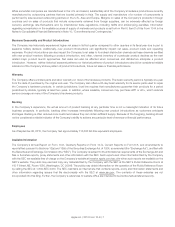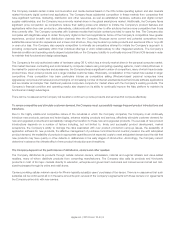Apple 2015 Annual Report Download - page 14
Download and view the complete annual report
Please find page 14 of the 2015 Apple annual report below. You can navigate through the pages in the report by either clicking on the pages listed below, or by using the keyword search tool below to find specific information within the annual report.The Company’s future performance depends in part on support from third-party software developers.
The Company believes decisions by customers to purchase its hardware products depend in part on the availability of third-party software
applications and services. There is no assurance that third-party developers will continue to develop and maintain software applications
and services for the Company’s products. If third-party software applications and services cease to be developed and maintained for the
Company’s products, customers may choose not to buy the Company’s products.
With respect to its Mac products, the Company believes the availability of third-party software applications and services depends in part
on the developers’ perception and analysis of the relative benefits of developing, maintaining and upgrading such software for the
Company’s products compared to Windows-based products. This analysis may be based on factors such as the market position of the
Company and its products, the anticipated revenue that may be generated, expected future growth of Mac sales and the costs of
developing such applications and services. If the Company’s minority share of the global personal computer market causes developers to
question the Mac’s prospects, developers could be less inclined to develop or upgrade software for the Company’s Mac products and
more inclined to devote their resources to developing and upgrading software for the larger Windows market.
With respect to iOS devices, the Company relies on the continued availability and development of compelling and innovative software
applications, which are distributed through a single distribution channel, the App Store. iOS devices are subject to rapid technological
change, and, if third-party developers are unable to or choose not to keep up with this pace of change, third-party applications might not
successfully operate and may result in dissatisfied customers. As with applications for the Company’s Mac products, the availability and
development of these applications also depend on developers’ perceptions and analysis of the relative benefits of developing, maintaining
or upgrading software for the Company’s iOS devices rather than its competitors’ platforms, such as Android. If developers focus their
efforts on these competing platforms, the availability and quality of applications for the Company’s iOS devices may suffer.
The Company relies on access to third-party intellectual property, which may not be available to the Company on commercially
reasonable terms or at all.
Many of the Company’s products include third-party intellectual property, which requires licenses from those third parties. Based on past
experience and industry practice, the Company believes such licenses generally can be obtained on reasonable terms. There is, however,
no assurance that the necessary licenses can be obtained on acceptable terms or at all. Failure to obtain the right to use third-party
intellectual property, or to use such intellectual property on commercially reasonable terms, could preclude the Company from selling
certain products or otherwise have a material adverse impact on the Company’s financial condition and operating results.
The Company could be impacted by unfavorable results of legal proceedings, such as being found to have infringed on intellectual
property rights.
The Company is subject to various legal proceedings and claims that have not yet been fully resolved and that have arisen in the ordinary
course of business, and additional claims may arise in the future.
For example, technology companies, including many of the Company’s competitors, frequently enter into litigation based on allegations of
patent infringement or other violations of intellectual property rights. In addition, patent holding companies seek to monetize patents they
have purchased or otherwise obtained. As the Company has grown, the intellectual property rights claims against it have increased and
may continue to increase. In particular, the Company’s cellular enabled products compete with products from mobile communication and
media device companies that hold significant patent portfolios, and the number of patent claims against the Company has significantly
increased. The Company is vigorously defending infringement actions in courts in a number of U.S. jurisdictions and before the U.S.
International Trade Commission, as well as internationally in various countries. The plaintiffs in these actions frequently seek injunctions
and substantial damages.
Regardless of the scope or validity of such patents or other intellectual property rights, or the merits of any claims by potential or actual
litigants, the Company may have to engage in protracted litigation. If the Company is found to infringe one or more patents or other
intellectual property rights, regardless of whether it can develop non-infringing technology, it may be required to pay substantial damages
or royalties to a third-party, or it may be subject to a temporary or permanent injunction prohibiting the Company from marketing or selling
certain products.
In certain cases, the Company may consider the desirability of entering into licensing agreements, although no assurance can be given
that such licenses can be obtained on acceptable terms or that litigation will not occur. These licenses may also significantly increase the
Company’s operating expenses.
Apple Inc. | 2015 Form 10-K | 12
























